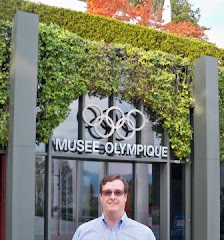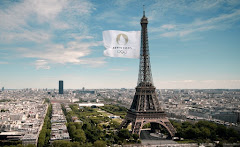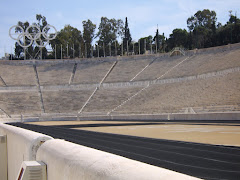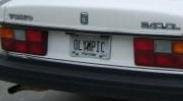
 Frank Lloyd Wright's good works are part of my memory since teenage years, but a 1994 exhibit at the Museum of Modern Art marked the first time the architect's fame and accomplishments "stuck" with me.
Frank Lloyd Wright's good works are part of my memory since teenage years, but a 1994 exhibit at the Museum of Modern Art marked the first time the architect's fame and accomplishments "stuck" with me.Wright's city plan for Baghdad intrigued me for its inclusion of an Olympic stadium in Iraq, though I cannot confirm whether the New York exhibit showcased that Wright design, or if the Olympic/Wright connection came to my attention later.
In the 17 years since experiencing that MOMA exhibit, however, each visit to a Wright destination either earned comparison to the Manhattan display, which set a very high bar for architectural exhibitions, or brought back memory of lessons learned in that temporary assembly of Wright drawings, models and materials.
Now showing at the Milwaukee Art Museum, the new exhibition "Frank Lloyd Wright: Organic Architecture for the 21st Century" gets it right, and sets another high bar for future exhibitions.
Students, fans or anyone curious about Frank Lloyd Wright will find the MAM show enjoyable, entertaining and informative, including a broad overview of Wright's career (covering most of the basics and big milestones in his work) and many surprises for those more familiar with Wright projects across the U.S. (the exhibit focuses on stateside projects).
Thanks are in order for the MAM media relations team, which arranged tickets for this blogger and a guest to visit the museum on March 5.
"Frank Lloyd Wright: Organic Architecture for the 21st Century" begins with a large room filled with enormous architectural models created at Taliesin or Taliesin West, Wright's homes and working studios in Spring Green, Wis., and Scottsdale, Ariz., respectively.
From the towering model of "The Illinois" -- a soaring design for a mile-high skyscraper in Chicago -- to panoramic three-dimensional displays of "Broadacre City" and "The Living City," Wright's visionary take on the possibilities for architecture on a citywide level, attendees are treated to handmade models and hand-drawn ideas that mostly lived only in Wright's mind, and on rare sheets of drafting paper. Only one or two designs in the room -- the Price Tower built in Bartlesville, Okla., and a synagogue in Pennsylvania -- made it from dream or proposal stage to construction.
The most unusual and surprising (and unbuilt) designs of the exhibition include rare, full-color renderings for the Rogers Lacy Hotel in Dallas (sigh for what could have been ...) and the Gordon Strong Automobile Objective, a scenic overlook and destination (rooftop for a massive planetarium) intended for Sugarloaf Mountain, Md., which shares spiral design elements that later appeared in the Guggenheim Museum's spiral atrium.
Following what I describe as the futuristic/unbuilt "room of dreams," the exhibit looks at a range of residential projects and designs for families. Attendees are treated to views of Usonian, Cloverleaf Quadruple and other private residences, showcased around several elements from Taliesin. My girlfriend and I tuned into some rare home movies from Wright's home before studying the designs for Falling Water, which is on our target list for the next Wright experience to share.
The best surprise in the "residential" sections of the exhibition: Large renderings for the unbuilt Raul Bailleres House, a beachfront property that would have included tiered infinity pools and waterfalls in Acapulco, Mexico, displayed beside a spectacular "Seacliff" house intended for waterfront property near San Francisco.
We later learned that the Bailleres House, with many updates and redesigns for other clients, now stands in Maui, Hawaii, as the "Marilyn's House" built in the 1980s (my girlfriend and I visited that beautiful site, which overlooks Haleakala Mountain, last year).
A cottage designed for bestselling author Ayn Rand was a nice surprise in the exhibition. Another delight was learning the back story related to the drawing.
We also enjoyed several drawings of the Frederick C. Bogk House, a Milwaukee home built on Terrace Drive near Lake Michigan. We delighted in driving from MAM to this residence, only a mile from the museum, on the same afternoon, and if time permits, we suggest any MAM visitors also make time to experience the Wright-designed Greek Orthodox Church in suburban Wauwatosa, Wis. (spectacular).
The Greek temple is one of a handful of iconic places of worship highlighted in the exhibition. The standout, of course, is Unity Temple of Oak Park, Ill., and MAM installed a shadow box-style model of the temple sanctuary.
Numerous office and government buildings -- some built, some only proposed -- come to life in more large illustrations and models, such as a large model of the S.C. Johnson headquarters of Racine, Wis. We enjoyed learning about Wright designs for Marin County, Calif., and the Lenkurt Electric Co.
There were only a handful of "holes" in the exhibition. We noted that both the Guggenheim Museum and Ennis House noticeably missing. I suspect the Guggenheim has its own stronghold on Wright artifacts, which the Manhattan institution may or may not be willing to share. In the case of Ennis House, and nearby Hollyhock House (also in Los Angeles, and also missing from the MAM exhibition), maybe its imperilled status factored for MAM exclusion.
But then, there are hundreds of Wright structures from which to choose, and MAM covered the right bases with great detail. Anyone can read more in the Frank Lloyd Wright Field Guide or other publications available in the exhibition gift shop.
For those who visit MAM, be sure to enjoy the lakefront dining experience at Cafe Calatrava in the lower level -- the cauliflower soup is magnificent, and the architecture-inspired menu (honoring the Wright show as much as the famed Spanish architect who created MAM's expansion 10 years ago) is great for fueling or refueling for a day at the museum.
Illustrations via MAM:
-- Lenkurt Electric Company, San Carlos, CA, 1955, © 2010 Frank Lloyd Wright Foundation, Scottsdale, AZ
-- Rogers Lacy Hotel, Dallas, TX, 1946, © 2010 Frank Lloyd Wright Foundation, Scottsdale, AZ














No comments:
Post a Comment